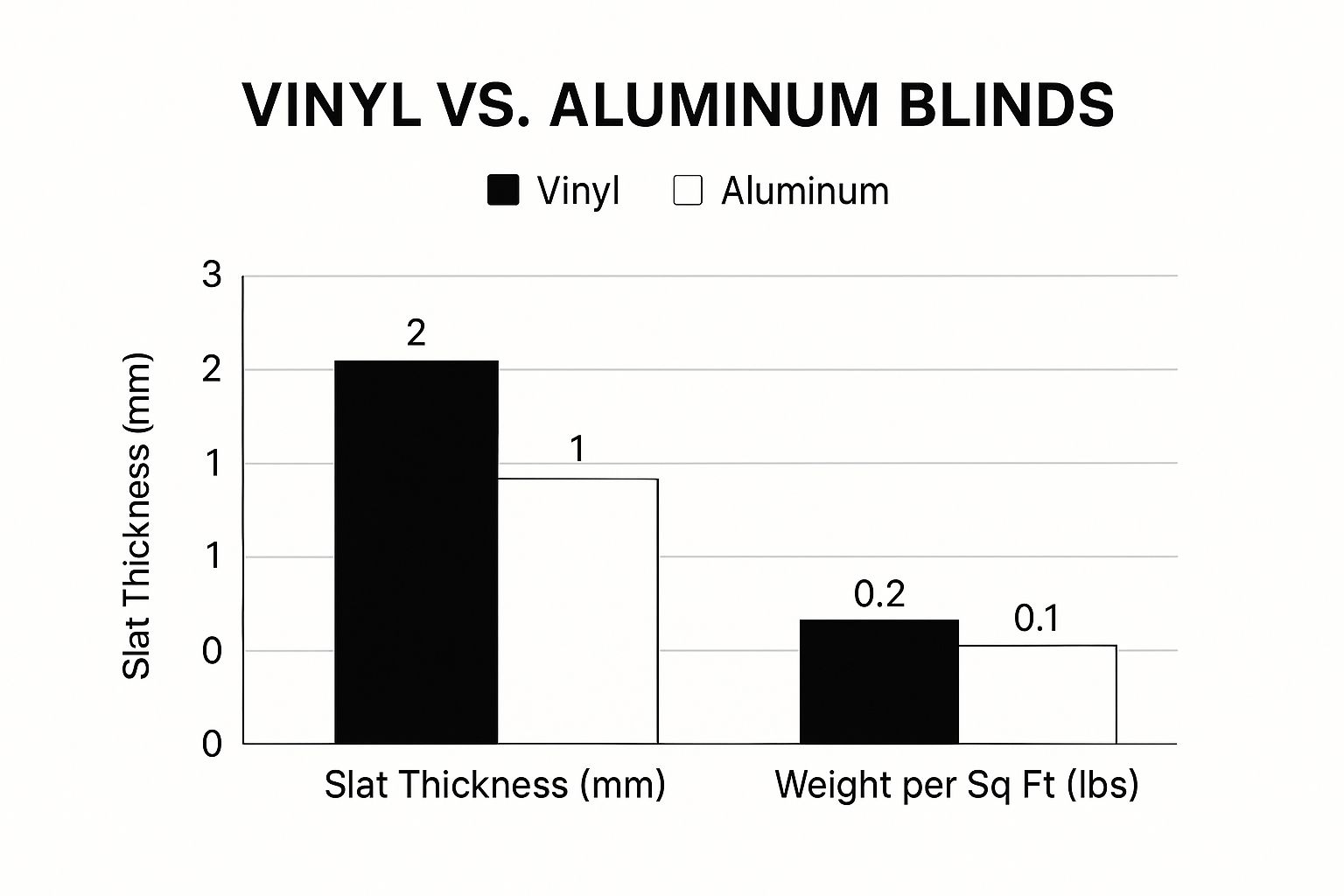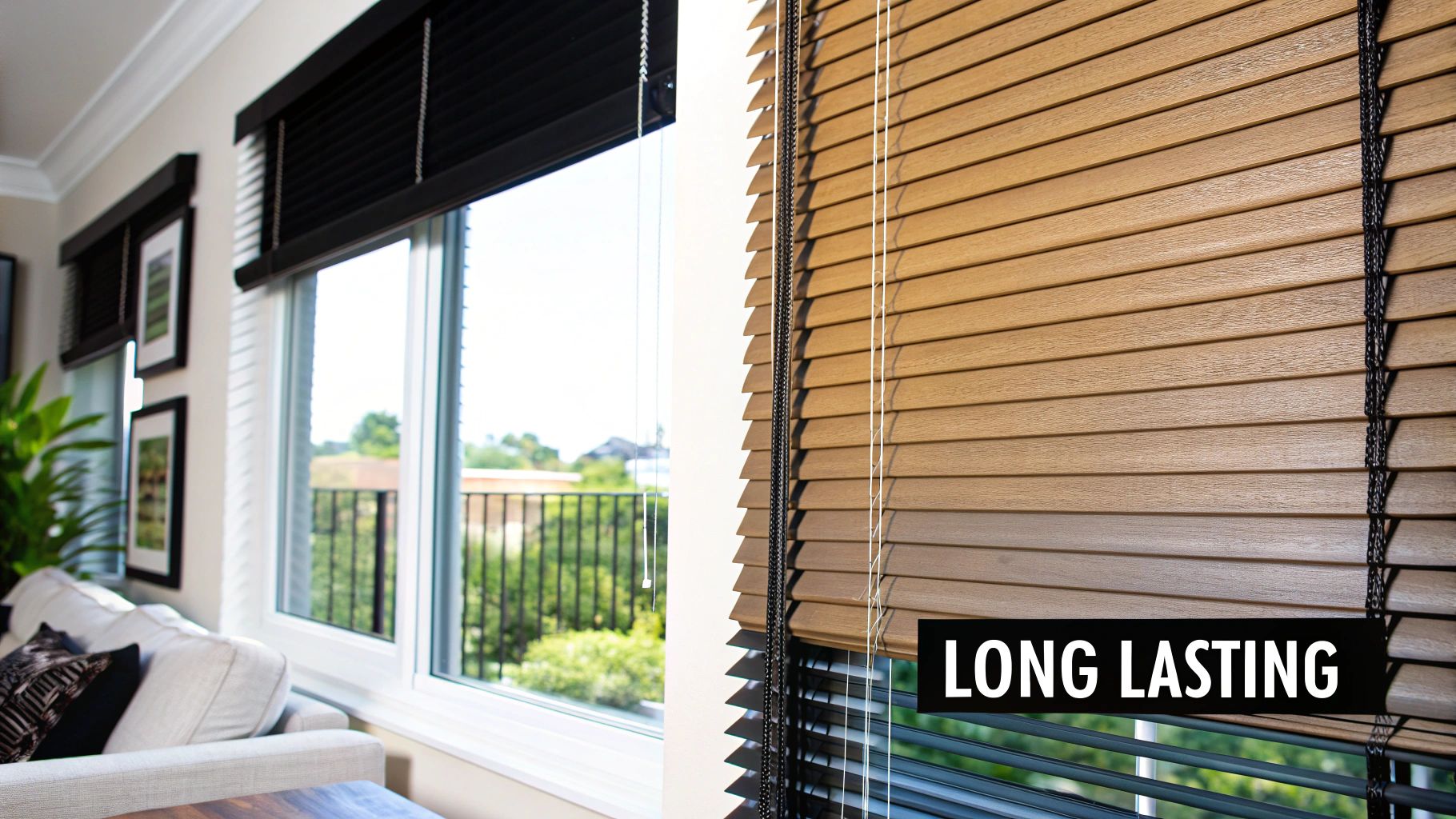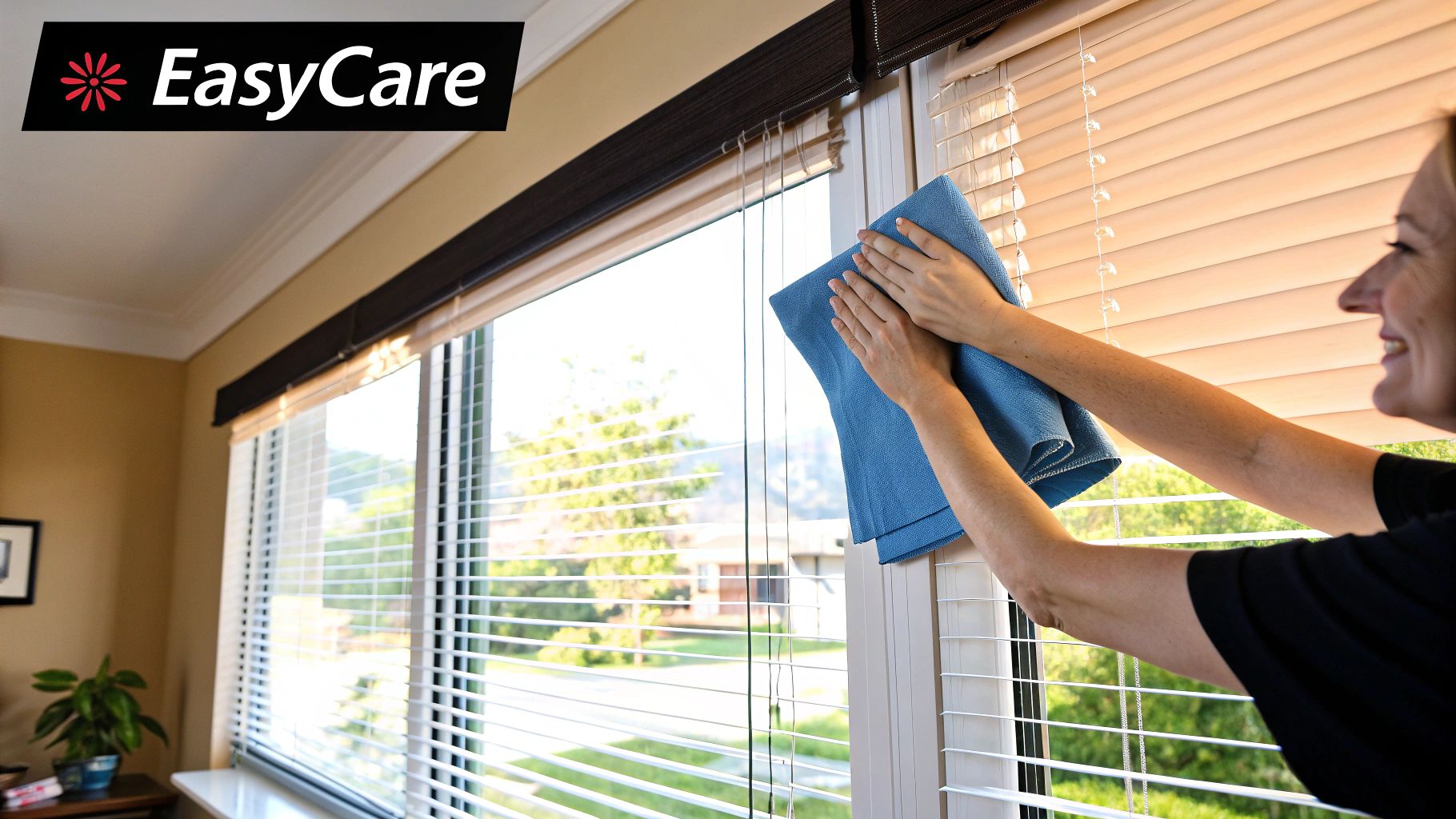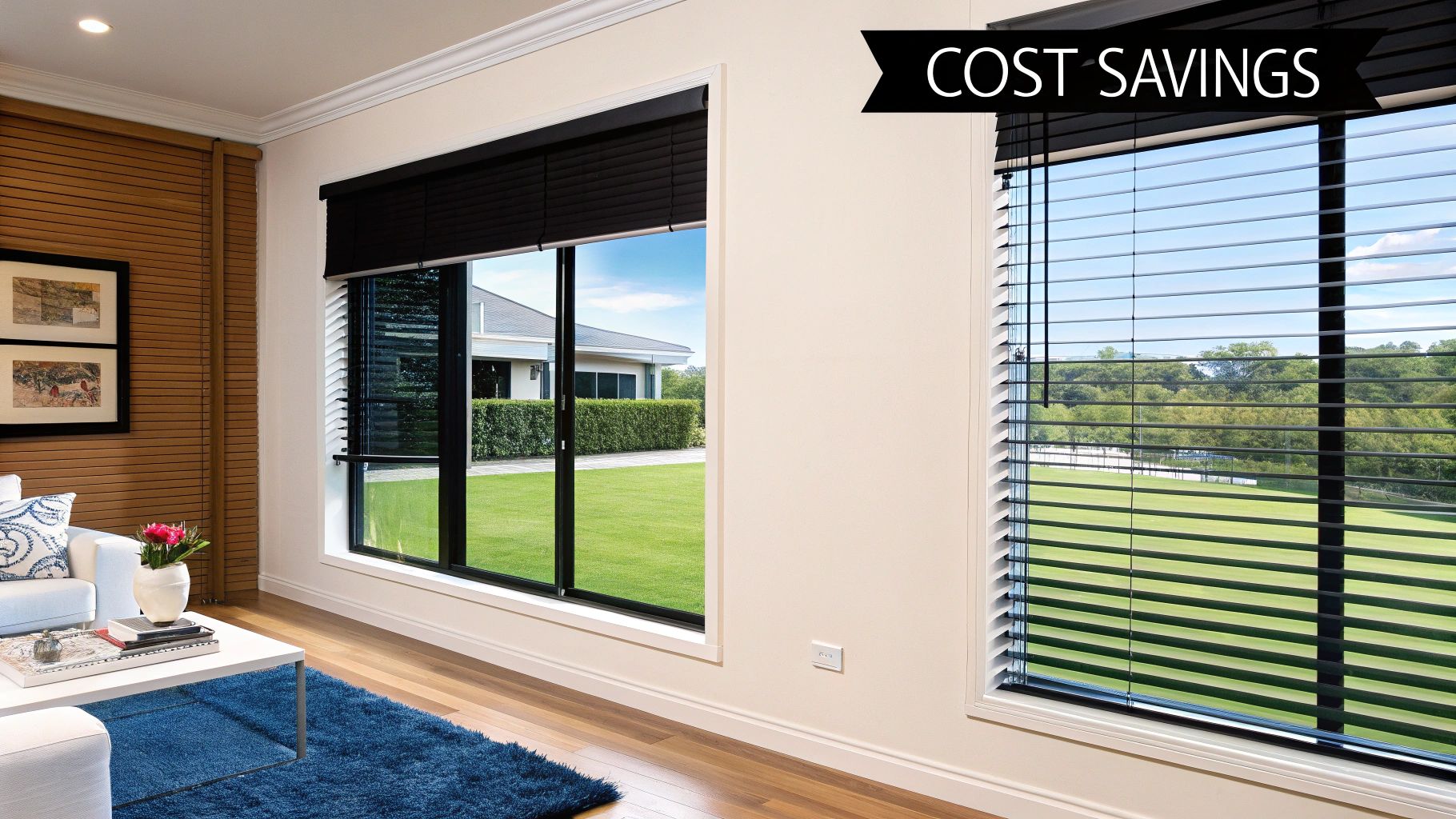Vinyl Blinds vs Aluminum Blinds: Best Choice for Your Home
- Johann Reardon

- Jul 18
- 13 min read
Understanding Your Window Treatment Decision
Choosing between vinyl and aluminum blinds is about more than just the material—it's about finding a solution that fits your home, lifestyle, and design vision. The vinyl blinds vs aluminum blinds debate requires looking past basic features to see how each performs under real-world conditions. At Home Blinds & Floors, our experience shows the right choice is deeply personal and depends entirely on the specific needs of your space and your daily routines. We'll explore the key differences that influence everything from light control to long-term maintenance.
Starting with the Basics
Before we get into a detailed comparison, it helps to understand the context. When you're choosing new blinds, you're part of a significant trend. The global blinds market was valued at USD 6.75 billion in 2024 and is expected to reach approximately USD 8.31 billion by 2030. This growth is driven by homeowners just like you who are looking for practical and stylish window coverings.
Both vinyl and aluminum blinds are popular choices contributing to this market growth, but they serve different purposes. Vinyl often appeals to budget-conscious buyers needing a moisture-resistant solution, while aluminum is prized for its durability and sleek finish. You can find more details on this growing market and its key drivers on Mordor Intelligence. Knowing this confirms you are considering two of the most relevant materials available today.
Factors That Shape Your Choice
The best window treatment solves problems without creating new ones. To make a smart decision, you need to consider a few critical factors that go beyond the initial price.
Room Location: A steamy bathroom has very different requirements than a sun-drenched living room. Moisture resistance is crucial in one, while UV protection is key in the other.
Daily Use: Think about who will be operating the blinds. Will they be adjusted frequently by adults, or do you need something that can stand up to curious kids and pets?
Longevity vs. Flexibility: Are you searching for a permanent, long-term installation or a cost-effective solution you might want to update in a few years?
Thinking through these points creates a solid framework for evaluating which material will truly serve you best. As a family-owned business, Home Blinds & Floors is focused on helping you find a durable, practical solution that enhances your home for years. For a deeper look at how these materials compare, check out our guide on which window treatment truly wins the vinyl vs. aluminum debate.
Real-World Cost Analysis: What You'll Actually Pay
When you're comparing vinyl blinds vs. aluminum blinds, the price on the shelf is only the first chapter of the financial story. While vinyl blinds often have a lower initial cost, a genuine cost analysis must account for long-term value, including customization, installation, and how often they might need replacing. Your total investment is shaped by more than the base material; it's also affected by window sizes, the hardware you select, and the complexity of the installation.
At first glance, standard-sized vinyl blinds are among the most budget-friendly window treatments you can find. However, if you have non-standard windows, the cost of custom-sizing can close the price gap between vinyl and aluminum considerably. For homeowners in areas like San Diego, a professional consultation can uncover these potential expenses and help create a more accurate budget. You can learn more about how to plan for your project by reading our guide on the costs of window coverings.
Beyond the Sticker Price: Customization and Longevity
The true value of your blinds becomes clear over time. It's important to consider a few factors that influence the total cost of ownership for both types.
Custom Features: Adding thicker gauge slats, unique finishes, or motorized window treatments will increase the price for either material. However, the percentage increase is often higher for aluminum because its manufacturing process is more involved.
Installation Nuances: For simple windows, installation is straightforward for both vinyl and aluminum. But for complex jobs, like mounting on tricky surfaces such as brick or tile, labor costs may go up, no matter which blind material you choose.
Replacement Cycle: In high-traffic areas or rooms with intense sun exposure, budget-friendly vinyl blinds may become brittle or discolor, requiring replacement within 3-5 years. On the other hand, well-made aluminum blinds can last 10-15 years or more, which often makes their cost-per-year much lower.
To help you decide, here’s a detailed breakdown of the costs you can expect with both vinyl and aluminum blinds.
Cost Comparison: Vinyl vs Aluminum Blinds
Detailed breakdown of initial costs, installation fees, and long-term maintenance expenses for both blind types
Cost Factor | Vinyl Blinds | Aluminum Blinds | Notes |
|---|---|---|---|
Initial Purchase (Standard Size) | $20 - $70 per window | $30 - $100 per window | Vinyl is the most affordable option for standard windows. |
Custom Sizing | Moderate increase; can double the base price. | Higher increase; can be 2-3x the base price. | The price gap narrows significantly for custom sizes. |
Professional Installation | $50 - $150 per window | $50 - $150 per window | Labor costs are similar unless specialized mounting is needed. |
Specialty Finishes/Features | Moderate | High | Costs for motorization or premium finishes add more to aluminum's price. |
Long-Term Replacement Cost | High (replace every 3-5 years) | Low (replace every 10-15+ years) | Aluminum's durability often leads to lower lifetime costs. |
Average Cost-Per-Year | $15 - $30 | $8 - $20 | This calculation assumes a 5-year life for vinyl and a 10-year life for aluminum. |
This table shows that while vinyl has a lower entry price, aluminum often proves to be the more economical choice over the long run due to its superior durability and longer lifespan.
The physical properties of each material, like thickness and weight, also play a role in their durability and how they are handled during installation, as this chart illustrates.

The data here shows that although vinyl slats are thicker, aluminum's lighter weight makes it a better fit for very large windows because it doesn't put excessive strain on the mounting hardware.
Ultimately, the most cost-effective option really depends on your specific needs. If you need a temporary solution or are covering a window in a low-moisture, low-traffic room, vinyl provides excellent initial savings. For a long-term investment where durability and a clean, modern look are important, aluminum often delivers superior value over time. At Home Blinds & Floors, our in-home consultations are designed to help you weigh these factors, ensuring your choice is not just affordable today but also a sound investment for the future.
Durability Testing: How They Perform Under Pressure

Impact and Material Integrity
The slats are often the first point of failure for any set of blinds. Aluminum blinds, especially those made from a thicker gauge, show a clear advantage in resisting direct impacts. They are much less likely to crack or snap from an errant toy or a curious pet. Although aluminum can bend or dent under heavy force, it usually keeps its structural integrity. A dented slat often remains functional, whereas a cracked vinyl slat is broken. This quality makes aluminum a top choice for high-traffic areas or homes with active children.
Vinyl, in contrast, offers more flexibility but less impact resistance. While modern PVC formulas have improved, extended exposure to direct sunlight can make the slats brittle over time. In a room that gets intense sun, vinyl blinds might snap easily after just 3-5 years of use. This tendency toward brittleness is a major factor to consider for windows that face strong afternoon light.
Environmental Stress: Humidity and UV Exposure
Your home's specific environment plays a huge part in how long your window treatments last. Both vinyl and aluminum perform well in high-humidity spaces like bathrooms and kitchens, as neither material will warp, swell, or develop mildew like wood. However, they react very differently to sunlight.
Aluminum: Its metal surface is naturally reflective, which helps protect the finish from UV rays. Quality aluminum blinds are typically treated with a baked-on enamel finish that resists yellowing and fading for a decade or more.
Vinyl: Although it's moisture-proof, vinyl is more vulnerable to UV degradation. Over the years, this exposure can cause discoloration and a loss of pliability. Cheaper vinyl is particularly susceptible to turning yellow or chalky, a sure sign that the material is breaking down.
For homeowners who value long-term visual appeal and dependable operation, the better UV resistance of aluminum often makes its higher initial cost a worthwhile investment. As a family-owned business, Home Blinds & Floors helps clients understand these subtle performance differences to ensure their custom window coverings last. Our in-home consultations in areas like Chula Vista let us evaluate your home's unique conditions and recommend a material that truly endures.
Style Impact: Creating Your Ideal Aesthetic

Aluminum: The Minimalist’s Choice
For a clean, industrial, or contemporary look, aluminum blinds are the clear frontrunner. Their thin, rigid slats form sharp horizontal lines, creating a structured and sleek appearance. They are particularly effective at reflecting light, which can help a smaller room feel brighter and more expansive.
Color and Finish: While available in various colors, aluminum makes its biggest impact in metallic and matte finishes. Options like brushed silver, chrome, and matte black provide a cool, uniform look that is hard to replicate with other materials.
Light Control Precision: The unyielding nature of aluminum slats allows for a very tight closure. This delivers superior light-blocking performance and presents a tidy, uncluttered profile when the blinds are fully shut.
Vinyl: The Versatile Contender
Vinyl blinds introduce a softer, more traditional feel to a space. Their slats are generally thicker and often come with embossed textures that mimic the appearance of wood or other natural materials. This adds a layer of visual interest and warmth that many homeowners appreciate.
Color and Pattern: Vinyl offers a massive catalog of colors and patterns, ranging from simple neutral whites and beiges to unique printed designs. This adaptability makes them suitable for nearly any decor style, from a playful child's bedroom to a cozy living room.
Aesthetic Flexibility: Vinyl absorbs more light than it reflects, resulting in a softer, more diffused glow throughout the room. This gentle light filtering is often preferred for crafting a relaxed and inviting atmosphere where harsh light is unwelcome.
The Home Blinds & Floors collection demonstrates the wide range of styles you can achieve with custom blinds.

Environmental Performance: Room-By-Room Analysis

The High-Moisture Test: Kitchens and Bathrooms
Moisture is a major problem for many window treatments, but this is where both vinyl and aluminum perform exceptionally well. Their non-porous surfaces make them completely waterproof, which means they won't warp, swell, or develop mildew like natural wood blinds often do. In these humid spaces, the decision really comes down to maintenance and style preferences.
Vinyl: The slats on vinyl blinds are generally thicker with a smooth, even surface, making them incredibly easy to wipe down. This is a big plus in kitchens where grease splatters are common or in bathrooms where soap scum can build up.
Aluminum: While also waterproof, aluminum's thinner slats and closer spacing can make them a bit more time-consuming to clean individually. However, their sleek, metallic look is often a perfect match for the modern fixtures found in many contemporary kitchens and bathrooms.
For these high-humidity areas, both materials are strong contenders, but vinyl often has a slight advantage because of its simpler cleaning routine.
The Sun-Exposure Challenge: Living Rooms and Bedrooms
Direct sunlight introduces a different set of issues: heat gain and UV damage. In rooms that get hours of direct sun, aluminum blinds have a clear performance edge. Their metallic surface acts like a mirror, reflecting a large portion of solar radiation away from the window. This reflective quality helps keep rooms cooler and can even lead to lower energy bills.
Vinyl, in contrast, tends to absorb more heat. When exposed to intense, direct sunlight over long periods, this can cause the material to become brittle. This increases the risk of slats cracking or snapping. Despite this, their widespread use in homes, which made up over 73.9% of the market in 2024, is often tied to their affordability and moisture resistance. The market for polyester and PVC materials was valued at nearly USD 6.5 billion in 2024, highlighting their popularity even with some UV sensitivity.
Special Considerations: Pets, Kids, and Sustainability
For households with active pets or young children, durability is a top priority. Aluminum’s metal construction provides better resistance to bending, denting, and breaking compared to vinyl. This makes it a more suitable option for high-traffic areas or rooms where kids play.
If you're focused on creating a greener home, it's a good idea to look into the materials and manufacturing processes behind your blinds. You can find more information in our guide on eco-friendly blinds for sustainable and stylish window options. The experts at Home Blinds & Floors can offer personalized recommendations during a free in-home consultation, making sure your new custom window coverings are perfectly suited to every room in your house.
Maintenance Reality: What Upkeep Actually Requires
Every window treatment needs some level of care, but when you're looking at vinyl blinds vs aluminum blinds, the real-world effort for cleaning and maintenance is quite different. Your choice here will decide whether you're performing quick, easy wipes or engaging in more detailed cleaning sessions. Understanding these practical distinctions is key to selecting a blind that fits your lifestyle, not just your window frame.
Daily and Weekly Upkeep
For routine cleaning, both materials are fairly low-effort, but they attract and show dust in different ways.
Vinyl blinds, with their thicker and smoother slats, are incredibly easy to clean. A simple pass with a duster or a damp microfiber cloth is typically all that's needed to handle dust and smudges. This makes them a fantastic option for kitchens, where grease and food particles can accumulate, as a quick wipe-down restores their clean appearance.
On the other hand, the thinner slats on aluminum blinds can be more tedious to clean one by one. Dust tends to settle on the many narrow surfaces, often requiring a more precise tool like a specialized duster or a vacuum with a brush attachment. However, their metallic finish is quite good at hiding minor dust accumulation when viewed from a distance.
Deep Cleaning and Stain Resistance
When it's time for more intensive cleaning, the material properties play an even bigger role. Vinyl's major advantage is its non-porous surface. It is highly resistant to stains and can be washed with mild soap and water without any risk of damage—a significant benefit in homes with active kids or pets. If you're looking for more detailed instructions, you can check out our guide on easy tips for sparkling windows.
Aluminum is also water-resistant, but its baked-on enamel finish can be scratched by abrasive cleaners or harsh tools. Gentle cleaning is crucial to protect its finish. While aluminum doesn't stain easily, sticky messes can be more difficult to remove from the thin slats without accidentally bending them.
To help you visualize these differences, here's a direct comparison of the maintenance tasks involved.
Maintenance Requirements Comparison
Side-by-side comparison of cleaning frequency, methods, and maintenance complexity for vinyl and aluminum blinds
Maintenance Task | Vinyl Blinds | Aluminum Blinds | Difficulty Level |
|---|---|---|---|
Dusting Frequency | Weekly | Weekly | Low |
Dusting Method | Quick wipe with a cloth or duster | Careful dusting of individual thin slats | Vinyl: Low, Aluminum: Medium |
Deep Cleaning Method | Washable with soap and water | Gentle wipe with a damp cloth; avoid abrasives | Vinyl: Easy, Aluminum: Moderate |
Stain Resistance | Highly resistant; non-porous | Good resistance, but can scratch | Vinyl: High, Aluminum: Medium |
Durability During Cleaning | Very durable; slats are flexible and thick | Prone to bending or denting if handled roughly | Vinyl: High, Aluminum: Low |
As the table shows, while both are manageable, vinyl blinds offer a simpler, more forgiving cleaning experience. The thicker, flexible slats can handle more vigorous cleaning without damage, whereas aluminum requires a gentler touch to avoid permanent dents or scratches.
The expert team at Home Blinds & Floors often advises that while both are low-maintenance, vinyl's simple wipe-and-go nature makes it the winner for absolute ease of care. During our free in-home consultations, we help homeowners in areas like Orange County assess which material's upkeep routine best matches their busy lives, ensuring your custom blinds and shades stay beautiful with minimal effort.
Your Decision Framework: Choosing With Confidence
Deciding between vinyl blinds vs aluminum blinds involves weighing your budget against your design goals and daily needs. After looking at cost, durability, style, and upkeep, the best option becomes clearer once you sort out your priorities. This framework is designed to help you make a solid choice, whether you're decorating a new home or just updating a single room. The goal is to match the material's advantages to your specific environment and lifestyle.
Scenarios Where Vinyl Blinds Win
In certain situations, vinyl is the clear winner because its unique qualities really stand out. You should lean toward vinyl if:
Your Budget Is the Top Priority: For rental properties, first homes, or any space needing a quick and affordable update, vinyl offers a clean look without a major investment. Its low upfront cost is its biggest draw.
Moisture is a Constant Concern: In bathrooms, kitchens, and laundry rooms, vinyl's waterproof and easy-to-clean surface makes it the better pick. It holds up against humidity and splashes without any fear of warping or damage.
You Prefer a Softer, Warmer Aesthetic: Vinyl can create a cozier, more traditional atmosphere than the sharp lines of metal. With options for embossed textures that look like wood and a broad palette of colors, it offers a gentler visual appeal.
When to Choose Aluminum Blinds
Aluminum shines in spaces where modern style and long-lasting performance are the main goals. You should seriously consider aluminum if:
Long-Term Durability is Non-Negotiable: If you want a "set it and forget it" window treatment, aluminum is the way to go. It resists bending, breaking, and sun damage much better than vinyl, making it a solid long-term investment, especially in high-traffic areas or homes with children and pets.
You Want a Sleek, Modern Look: The thin, clean lines of aluminum slats are a perfect match for contemporary, minimalist, and industrial interiors. Finishes like brushed metal or matte black can add a sharp, polished touch to a room.
The Room Gets Intense Sunlight: Aluminum's ability to reflect solar heat makes it an excellent choice for south-facing windows. This not only protects your furniture and floors from fading but can also help keep the room cooler in warmer months.
Making the Final Call with Expert Guidance
Ultimately, your choice will come down to which factors matter most to you. If cost is the primary driver, vinyl is a sensible selection. If you put a higher value on longevity and a modern design, aluminum is the better investment over time. For more in-depth advice on balancing these factors, our guide on how to choose window treatments provides additional expert tips.
Sometimes, the best decision comes from getting a professional opinion. A free in-home consultation with the team at Home Blinds & Floors can make all the difference. As a family-owned business, we focus on personalized service, helping you evaluate your space and choose custom blinds and shades that fit your vision and budget perfectly.
Ready to find the perfect window treatments for your home? Contact Home Blinds & Floors today to schedule your complimentary consultation and explore our wide selection of high-quality blinds.

.avif)
Comments